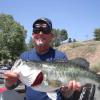capnsully gave me a tip that works.
Cut the joints while the lure block is still rectangular almost through, but leave about 1/8" in the middle uncut.
Then, while the lure's still square, drill the hinge holes.
Someone else here posted another tip about using a center pin on the drill press to make sure your holes line up, drilling 1/2 way from each side, slowly.
While the lure's still square, drill your hook hanger and ballast holes. Use your lure outline on the block to gauge the depth you need for these. If you don't got deep enough, but have the holes started, they're not hard to deepen after the lure is shaped. And, if they're too deep, you can wad up some newspaper and jam it into the hole before you add the hangers or ballast, to get rid of the extra depth. It's all sealed, anyway, so the paper isn't a problem.
Then you can shape your lure, finish your joint cuts (I use a dovetail saw, a little, fine toothed handsaw), and you're good to go.
Remember, you can drill your pin holes a little farther from the finished joint if you want to, since you're probably going to steepen the angle of the joint on the hinge pin pieces anyway, to get a free swinging joint.





